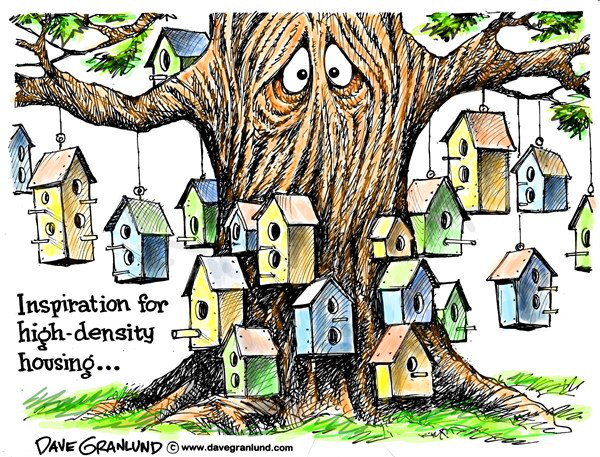Avoiding Accessory Dwelling Unit Pitfalls
Good Rules Are Needed for a Good ADU Outcome

California’s Accessory Dwelling Unit (ADU) law might promise below-market-rate housing within existing neighborhoods using green infill techniques consistent with the state’s greenhouse gas reduction goals, and all while protecting the existing neighborhood’s architectural character. But, it is much more likely to deliver more crowded neighborhoods littered with cars of (mostly) market-rate housing, built with no regard for the environment.
California has a long-standing goal of 50 @ 2050 (50 million residents by 2050), a 30 percent increase in population from today’s levels. But, that same set of Finance Department projections acknowledges today’s “Total Fertility Rate” is 1.8 (below “replacement rate”) and forecasts it will fall even further to 1.6 by 2060. California’s population is declining — unless you include immigration. But consider an article in the Sacramento Bee, which on April 4, 2016, stated, “Net migration into the state has slowed to a trickle.” It demonstrated a decrease from the 1980s’ net immigration of 3.5 million to 136,000 since 2005. “Immigration from Mexico, which previously drove much of California’s growth, has slowed markedly,” it ably demonstrated.
The state’s population targets are designed to grow the population in order to grow the economy using current economic models. Yet detailed analysis by Tom Murphy, PhD, of UC San Diego, evaluating “energy use” as a proxy for growth, demonstrates continued growth at current rates is impossible in the mid to long term. Rather than leading the world in creating a sustainable economy with a stabilizing population (a worldwide phenomenon in “developed” countries), California looked to the past and gave us ADUs to force population growth, not to provide affordable housing. We deserve better.
Since 1927, California’s local governments have planned their own communities. But with the ADU law, the state threw local planning under the bus. It has imposed an autocratic “centralized government” planning mandate — a power grab of monumental significance. This law eliminates most local government (and all neighbor) input/ control of their communities, prohibits consideration of environmental consequences, and does it using a “one size fits all” approach, even though some of California’s regions are projected to grow by more than 39 percent while others are projected to contract by a negative 12 percent.
Desirable social, environmental, and planning goals are mentioned in the ADU law, but it creates no provisions to enforce them. For instance, greed will rule the marketplace as ADUs are built because no long-term affordability provisions are made.
For greenhouse gases to be reduced by the ADU, low-emission vehicles, alternate transportation technologies, and/or linking ADU location to job location should be in the law, but they are not.
The ADU contains no restriction on the number of cars per parcel, which would allow parking to litter our streets. It does permit local jurisdictions to establish design standards to address common planning concerns.
For those regularly involved in planning, problems come immediately to mind with the “one in every backyard” ADU law. The term “parcel intensity” considers both the total square footage of buildings, uses, and impacts. Neighborhoods retain their character when all parcels have similar intensities.
Since ADUs increase use, a parcel’s “intensity” can only be maintained if the total building size is at or below the neighborhood average. Some will consider this too restrictive, given the “by right” provisions of the law, but we should start small and adjust upward if everything proves workable.
The danger of buildings set too closely together would be remedied if setbacks were adhered to, with twice the zoning setback a decent goal. “Setback averaging” should never be used. Similarly, building heights should respect the neighborhood, and be limited to 12 feet. Adherence to proper setbacks and height limits can resolve noise and view issues before they arise, and 6’8” dense hedges should be placed between ADUs and their neighbors. ADU “activity areas” must also be located outside of the setbacks, and noisy vehicles banned.
Alternative implementation strategies should include doing what is expected. In other words, each jurisdiction should craft an ordinance adhering closely to the state’s model ordinance.
The ADU law permits local jurisdictions to designate areas where units may be permitted, and “the designation of areas may be based on criteria, that may include, but are not limited to” certain criteria. Taking advantage of the broad latitude for “designating areas,” a community can start with the 10 percent largest parcels, then the next largest 10 percent of large parcels, etc. while monitoring ADUs’ effects on the community, tweaking the ordinance as needed. A phased approach enables rational, fact-based assessments of ADUs as they are “rolled out.”
Implementing ADUs could provide affordable housing, and the county’s ordinance should adopt the good provisions of the state law and correct the egregious ones. Items to add include, a long-term affordability requirement, special incentives for community health and safety employees (hospital workers/police/fire), linkage of housing to work proximity, discretionary review requirement, sensible parking requirement — restricting total number of motor vehicles per parcel, and requiring all parking to be on site, energy efficient vehicles, and “new technology” transportation as it comes on line.
Any ordinance must not grant an ADU “by right” or allow “special” parking provisions and exemptions. It must allow the consideration of other planning laws and environmental review.
Please contact your local leaders and ask them embrace the alternatives suggested above. The paternalistic/autocratic approach taken by the state does not celebrate all that is great about California; it flies in the face of it. Also, please contact your state assemblymember and senator and ask them to not only repeal or fundamentally revise the existing ADU law but also to stop considering all other state-mandated housing-related legislation, such as SB35 Wiener.



